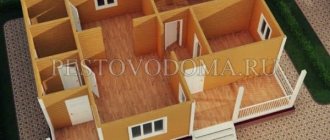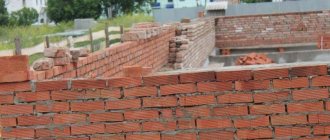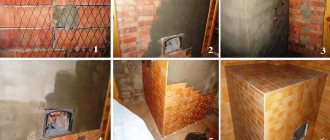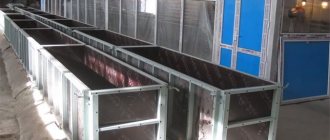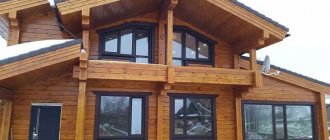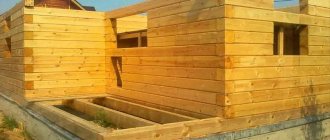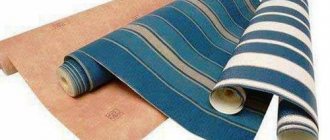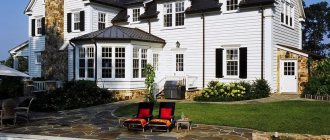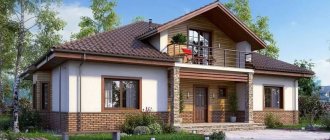Before starting to build their home, private developers, as usual, carefully compare different materials. But if the choice is made in favor of a wooden frame, then you should definitely find out about what is a gun carriage and what advantages do houses made of this material with an exotic name have, familiar to many only from Lermontov’s poem about Borodino.
The construction technology is quite interesting, but, of course, it is worth turning to those who are good at it for construction. Private specialists should not be considered. Moreover, try to master Norwegian cutting techniques on your own. This company produces quite good, correct houses from gun carriages. And the wood is excellent - the house will be excellent and will last for a very long time.
Types of carriage
Depending on the shape and working properties, this type of lumber comes in several types. Let's look at the features of each of them in more detail.
Calibrated
To obtain a calibrated carriage, the log is sawn from the top and bottom sides. The edges are often planed using a special machine. But on sale is calibrated lumber with edges of a natural, not always even, appearance.
The wood is dried in a special chamber before calibration. The fire monitor material can also be profiled by cutting out a groove and a ridge on it.
The width, height and roundings along the entire length of the calibrated carriage must be the same.
Uncalibrated lumber is an ordinary larch, pine or cedar log that has been cut on both sides.
Norwegian
The Norwegian carriage is popular among contractors and owners of finished buildings. Monitor baths, small country houses and entire country cottages are in demand. To produce Norwegian lumber in production, the log is first cut down on both sides. Careful sorting by size is carried out so that all elements are the same length, height and width. Then the blanks are stored in a warehouse from six months to 1.5 years. At this time, the material dries naturally. The humidity of finished fire monitors usually does not exceed 20%.
Chamber drying
Another finished woodworking product is a chamber drying carriage. The wood is placed in a vacuum drying chamber.
It is worth knowing that as a result of drying, approximately 200 kg of moisture is removed from 1 cube of raw logs. Therefore, dry wood is many times lighter than raw wood.
When building houses, kiln-dried lumber reduces the shrinkage of the log structure to a minimum and significantly reduces the time it takes to start using the house.
Faceted
To obtain faceted lumber, the log is sawed on the sides, laid on edge and planed at an angle of 45 degrees. It turns out that the rectangular blank turns into an octagonal one. Next, the workpiece is subjected to natural or chamber drying.
Where is a carriage used in construction?
Carriage is an excellent building material for the construction of residential buildings, bathhouses, and cottages. A properly laid log house will last for centuries without requiring repairs. The room inside turns out to be warm, cozy, and the outside will look very beautiful.
Buildings made from gun carriages fit perfectly into a rustic, chalet or country style.
Log houses are in great demand in Norway, Finland, North America, and France.
In addition, cedar lumber is an indispensable basis for the frame of a house. The frame is neat and beautiful; additional finishing is not necessary.
In terms of performance characteristics, it is not inferior to a log or timber.
People often search for:
- Construction of frame baths
- Russian bathhouse at the dacha
What kind of wood is best to use for a gun carriage?
The best breeds for making gun carriages are:
- larch;
- pine;
- cedar.
The procurement of raw materials is done in winter, when growth and any metabolic processes in the trees are suspended. The logs are carefully sorted to completely eliminate wood with defects or damaged by insects or fungus.
For the construction of houses, only large diameter round timber is used. The height of standard monitor lumber is 28-40 cm. The thickness can be from 18 to 24 cm.
Lumber of natural moisture content can be used for construction, but when making calculations it is important to take into account the shrinkage process. Over time, the carriages will fit even more tightly to each other.
Chamber drying material speeds up the process of putting a building into operation, since the shrinkage process is no longer relevant.
Thanks to the significant size of the wall material, fire monitor houses look solid and quite massive.
The cheapest will be a pine carriage. Cedar and larch are much more expensive, but stronger and more durable. All materials are highly resistant to moisture, durable and provide excellent sound insulation.
Forest selection
Fire monitor lumber is made from pine, cedar, larch, and spruce.
When choosing, it is worth considering the features of raw materials:
- Pine is a practical lumber with a dense structure that is easy to process.
- Cedar is a durable, heat-intensive wood with a beautiful texture and is easy to process. The cedar trunk contains resin with natural antiseptics, so it does not grow mold or be undermined by insects.
- Larch is a durable, moisture-resistant tree that is resistant to temperature fluctuations. It has excellent thermal insulation and antiseptic properties.
For construction, it is better to choose logs without cracks at the ends, without traces of blue stains, pests or damage.
Pros and cons of the gun carriage
Among the advantages of using this lumber it is worth noting the following:
- Excellent thermal insulation properties. With a smaller thickness of wooden walls, a house made from a gun carriage is still warmer than a building with thicker brick walls. The rooms warm up quickly. In summer the house keeps cool well.
- Economical. A building made from a gun carriage will be cheaper than a brick building.
- There is no need for interior or exterior finishing of structures. The wooden frame looks equally beautiful inside and out.
- Short construction time. Building a house from wood can be done many times faster than building a building from brick. It is not necessary to pour an expensive slab foundation under it. You can get by with screw piles or tape.
- Providing good air exchange in the premises, since wood has excellent ventilation properties. The walls will not accumulate moisture and freeze.
- Environmentally friendly material. Does not release toxins. Safe for health.
- Durability. Log houses can last for decades, maintaining their integrity and the necessary working properties.
- A cedar carriage has healing properties because the wood contains natural antioxidants. The cedar aroma has a beneficial effect on the respiratory system. Strengthens the immune system.
- Comfortable microclimate in the house. The natural material emits a pleasant woody aroma. A pleasant atmosphere is formed.
- Beautiful and majestic appearance of the building. Buildings made from gun carriages always look massive, but at the same time they are neat and unique in appearance.
The disadvantages of any wood material are easy flammability and susceptibility to influence (fungus, damage by insects). But a solution was found a long time ago. After all, in order for a residential building to comply with fire standards, all its wooden elements are treated with fire retardants, and to protect against moisture - with antiseptics.
Beam, log or carriage - which is better for building a house
In terms of performance characteristics, logs, beams and carriages are very similar, so it is impossible to say unequivocally that any material is better or worse.
But there are points worth paying attention to:
- The timber and carriage are less resistant to moisture than sanded logs, so they require careful treatment with antiseptics.
- In houses made of carriages, the number of inter-crown joints - sources and bridges of cold - is several times less than in timber or log houses.
- The strength of the Norwegian castle makes wooden joints only stronger and stronger over the years.
- Fans of modern design styles think that houses made of laminated veneer lumber look much more attractive than buildings made of gun carriages. On the contrary, fans of antiquity and originality will like the gun carriage.
- Ready-made house kits will cost several times less than building a house from timber or logs from scratch.
If the material is delivered by road to the construction site and adjusted to individual dimensions on site, then the cost of such a house made from gun carriages will increase significantly.
The history of its appearance
This technology came to us from the Scandinavian countries
This technology came to us from the Scandinavian countries. It was not by chance that such building material appeared, but for the purpose of saving. After all, the larger the log, the stronger and warmer the walls of the house. But it is expensive. Therefore, the pine was cut off on both sides. The slab obtained in this way was used to cover the floor or roof. Thus, the entire array was put to work, without a trace. Thanks to the unique fastening of the crowns (a special lock and wooden dowels), the corners of the walls of the Scandinavian houses were windproof in harsh climates, and the dwelling itself was extremely strong and stable.
Fastening logs with wooden pins - tenons - was also used in Rus'. And on the stacked logs for insulation they left sap (the layer under the bark).
Cutting methods
Let's look at the most common methods of cutting and interlocking joints in private construction.
"Norwegian"
This cutting method was invented in Scandinavia. Since the type of log house gained the most popularity in Norway in private construction, hence the name. This corner connection is a self-jamming lock. For cutting, they take a carriage in the form of a semi-oval log or double-edged beam.
When drying, the wedge-shaped lock only becomes denser, the elements adhere better to each other. The room retains heat well. The costs of using interventional material are minimal.
The Norwegian lock prevents the carriage on the crowns from twisting or deforming. An excellent option for a residential building or bathhouse.
"In the saddle"
The method of cutting into the saddle is very similar to the Canadian technology, but still has differences. One of the main ones is that there are no tongue and groove elements. This significantly speeds up the assembly process, but the strength of the object will be lower than in the Canadian installation option.
A trapezoidal bowl is cut out on the carriage. The quality of the joints during the shrinkage process remains at the highest level. The self-jamming lock only becomes stronger over the years.
This cutting method can be easily mastered by a master even with little experience. If the technology for laying the elements is followed, the structure will remain airtight for a long time.
"Canadian"
An important advantage of Canadian felling is that the upper part of the carriage wood (sapwood) is not removed. Thanks to this, the material has increased resistance to moisture and external influences. The soft internal structure of the tree is reliably protected.
The shape of the Canadian bowl is trapezoidal. All work is done entirely by hand.
Other advantages of Canadian logging are worth noting:
- heat losses are minimized;
- internal corners are protected from moisture;
- the service life of wood increases;
- a pleasant microclimate is maintained for a long time;
- convenient placement of inter-crown insulation.
After shrinkage of a log house built using Canadian logging technology, caulking of its parts is not necessary.
The bowl has a tenon (inside) and a groove (in the upper part of the carriage), which ensures reliable connection of the elements with each other. The connections are self-locking and only get stronger over time. This structure remains sealed for a long time. The formation of cracks, even partial, is excluded.
"In a Hook"
Hook cutting can be done in two fundamentally different ways. Among them:
- The bowl is cut to the middle of the carriage on one side only. A groove is made in the upper part of the lafetina to the level of the rest of the prepared part of the bowl.
- The inside of the log is combed to a quarter of its diameter. The lock is secured with a tenon, which is attached to the part that is not hewn. The result is a smooth log house with right angles.
If we consider the strength and durability of the felling, “ hook” lock is many times inferior to the Canadian and Norwegian lock.
"In the fat tail"
In fat tail - a method of cutting when a longitudinal tenon is made on the lower part of the carriage. This carriage is inserted into a recess of similar size, reminiscent of an eye (groove). The tongue-and-groove fixation makes the connection as strong and airtight as possible.
An example of fat tail cutting is shown in the photo above. When cutting into a fat tail, the crowns are reliably protected from heat loss and blowing.
"To the clap"
Another name is Siberian bowl. The crowns are adjusted in size to each other, which is why the carriage has to be constantly turned over. Thanks to the crowns turned down, the reliability of the felling increases, moisture and water do not accumulate during precipitation.
The frequency of maintenance of such a structure is reduced.
Hollow felling is often practiced in the construction of summer houses, bathhouses, and houses with terraces.
“Into the bowl” (into the cloud)
It is considered the easiest way to cut.
Among the advantages of this method:
- simple assembly;
- construction speed;
- excellent thermal insulation;
- long service life.
One of the disadvantages of felling in the oblo is the loss of the useful length of the lafetina up to 1 m. This is due to the fact that the ends protrude beyond the corners of the building by approximately 30 cm.
Felling can be done in 2 ways:
- bowl up;
- bowl down.
It is convenient to mark the cutouts using a carpenter's compass.
Before and after the shrinkage of the log house, caulking of the wooden elements is performed.
It is important to remember that the size and shape of the bowl in the top log must match the bottom log. Insulation is laid between the crowns.
These materials will be useful:
- Brick stove for a Russian bath
- Electrical wiring in the bathhouse
The main stages of assembling a Scandinavian log house
First, a log house design
. The drawings mark the places where pipes and electrical wires will be laid, taking into account loads and structural components. Be sure to perform 3D modeling of the log house on the selected type of foundation.
The carriage is prepared for assembly in two main stages:
- bowls and grooves are cut out;
- drill holes for dowels.
Bowls
Initially, they are marked “roughly”, that is, the imperfect workpiece is cut out with a chainsaw. In this case, marking is carried out with the obligatory use of a hydraulic level. The roughing cup corresponds to the profile of the lower transverse rim. Before finishing marking and cutting the finishing bowl, the crowns are adjusted and marked.
The grooves are selected manually using an adze or a straight axe. To make the task easier, longitudinal cuts are made with a chainsaw before doing this.
A drill with a diameter of 30 mm is used for drilling. The holes for the dowels should be staggered. The dowel extends into the body of the lower crown (carriage) a maximum of 150 mm. The pitch between dowels is up to two meters.
The log house must first be assembled without dowels, all defects are checked and corrected. Only after this is the capital assembly of the log crowns on the foundation. The first crown should lie on antiseptic embedded boards up to 6 cm thick. It is more convenient to assemble heavy crowns using a truck crane. The adjustment of the upper crowns is carried out by installing scaffolding. Openings for windows and doors are cut out immediately during the assembly process (immediately with trimming).
Pediments
They are also assembled from a gun carriage. The technology is identical to the assembly of log walls. The ridge beams and slabs are secured into the cut-out gables with a notch (it is in the pediment logs that the bowls are cut for laying the ridge and the ends of the slabs, otherwise proper strength will not be ensured). The last stage of work is filing the ends of the gables according to the selected roof slope. The roof itself can be anything, insulated options are preferable.
It is extremely important to use expansion joints for all vertical elements of the frame. These elements will not allow the geometry of the building to be disrupted. It is recommended to install windows and doors some time after construction
This measure is associated with the uneven shrinkage of wood under the influence of solar (IR) rays and the need for high-quality ventilation of interior spaces
Windows and doors
It is recommended to install some time after construction. This measure is associated with the uneven shrinkage of wood under the influence of solar (IR) rays and the need for high-quality ventilation of interior spaces.
The finishing of the floors and ceiling can be chosen at the discretion of the owner. After completion of construction, the walls are thoroughly sanded and then covered with beeswax impregnations.
Here it is important not to rush into painting or varnishing, since most manufacturers indicate that the wood can be wet at a maximum of 12-14% before processing. A higher moisture content in wood will lead to a change in the properties and shade of the composition applied to the walls.
In restrooms where the walls are expected to be tiled, moisture-resistant plasterboard sheets are initially installed. The sheets are mounted on a frame with movable brackets to which the guides are fixed.
The outside of the walls can be coated with a composition containing linseed oil. There is no need to caulk or putty cracks in the log house.
All communications
in Scandinavian log houses they are laid in accordance with the rules for arranging wooden houses.
- Radiators are hung on brackets driven into the walls. Pipe connections are made through interfloor slabs and vertical ducts.
- The wiring of water and sewer pipes is similarly laid out in boxes located in the bathrooms or restrooms of the house/bathhouse.
- Electrical wires are pulled in such a way that the network can be repaired at any time. The wires are insulated with metal hoses, metal pipes or plastic pipes (low-current networks).
- For hidden wiring, shallow grooves are made in the thickness of the walls. For distribution boxes and sockets, holes of the required size are drilled in the wood. You can lay wires behind baseboards and in grooves behind door frames. If the entire volume of wires does not fit behind the baseboard, then it is permissible to groove a horizontal channel at the crown of the log house (maximum groove depth is five centimeters).
- The wiring to the ceiling lamps is pulled along the interfloor ceilings.
Norwegian castles will be difficult to make for a beginner. It will take much longer to prepare the material and cut it than to build a Russian log house. Just laying the crowns requires at least two weeks, so it’s worth assessing your strength and the amount of time allotted for construction in advance.
How to choose a ready-made log house from a gun carriage for a home or bathhouse
To make the right decision, you need to study the drawing, the finished project of the structure. Realistically assess the limits of the financial budget. Determine what area of living space, number of rooms and floors are needed. Check with the customer how transportation will take place. The necessary materials will be delivered to the construction site or the cutting will be carried out on site.
Log houses made from carriages can always be visually distinguished from log houses made from ordinary logs or timber. The material has a special arrangement of cracks in the center of the plane. This does not affect performance in any way.
The log house does not require finishing of the walls. The exception is the northern regions of the country, where additional insulation is necessary.
The height of the crowns in fire carriage buildings is always greater than in traditional houses.
In addition, with the same dimensions of the foundation, the useful area of the fire monitor structure is larger than that of a house made of timber or logs, and the consumption of building materials is less.
Ordering a finished log house should be done from reliable companies that are ready to enter into an agreement with the client, which will indicate each stage of the work, its cost and completion time.
Video description
About the technology of construction from gun carriages in the following video:
The method is not without its drawbacks:
- Complexity of technology . The reason for the slow spread of carriage technology is the complexity of the Norwegian lock. The work is labor-intensive and highly precise, requiring skill, time and adjustments.
- Preparing fire monitor logs . When processing the top, protective layer of wood is removed from both sides. Over time, cracks appear on the surface (from which not a single cutting method protects), which are not deep or, especially, through. The material may experience the usual problems: rot and mold. To extend the service life of a log house, it is recommended to treat it with an antiseptic and fire retardant once every two to three years, and after 5-6 years to re-caulk it.
The complex execution of a Norwegian castle requires great skill Source softlot.ru
Is it profitable to make a carriage with your own hands or not?
Making your own carriage from logs will save you a significant amount, but this will require free time and a little skill. If there is a desire, then the short order of work looks like this:
- Removing bark from logs. For this, a regular ax or staple is enough. You need to work carefully so as not to damage the barrel.
- Cutting down slabs. A standard chainsaw with a 75 cm bar is suitable for the procedure. The teeth of the bar should be sharpened for longitudinal cutting.
- Processing logs on a sawmill. It is important that the characteristics of the sawmill allow it to process logs of a certain size. The supporting part of the future carriage is being formed.
- Use a plane to grind off the remaining irregularities from the surface.
After preparing the carriage, the corners of the desired shape and dimensions are cut. Next, all workpieces are treated with an antiseptic and fire retardant. Allow to dry. Then you can start assembling.
Manufacturing Features
The technology for manufacturing the carriage, as already mentioned, appeared in Russia, quite recently - about 15 years ago. How to make a gun carriage? This log manufacturing technology is also called “Norwegian” because of the country of origin. First, the side parts of the logs are cut off, and then the bark is removed from the remaining rounded sides. After this, the entire log is planed by hand and grooves are cut out. The entire distinctive feature of such a log house is the unusual shape of the logs. They have a semi-oval shape with flat sides, which allows you to make the walls of the house smooth and do not require additional processing. This form of logs also allows them to better adhere to each other, eliminating the possibility of cracks. In a word, this technology has become very popular in Russia due to its cost-effectiveness and ease of working with ready-made logs. And it is undoubtedly appreciated by professionals in this field.
What performance characteristics should houses made from gun carriages have?
A properly laid out house using technology has the following characteristics:
- The structure is not afraid of shrinkage. Corner joints (locks) only become tighter and stronger, and fit closer to each other.
- There is no risk of deformation of the logs, even after a long period of use.
- You can build from wood of natural moisture and chamber drying.
- Cuts are made at the top and bottom of the carriage. Promotes minimal formation of longitudinal cracks. Door and window openings do not warp.
- The Norwegian cutting method is considered the warmest. The structure remains sealed for many years.
The construction team that will assemble the log house must provide a guarantee for the work performed and the quality of the material.
Average prices for houses from gun carriages
To have an idea of the cost of a finished house, you need to understand how much a cube of lumber will cost. Its price depends on the size. Examples of average prices for gun carriages in Russia are given in the table below:
| Size, mm | 140×140 | 140×190 | 190×190 | 190×240 | 200×240 |
| Price for 1 cube, rub | 10500 | 11000 | 12 000 | 13 000 | 21 000 |
The type of wood used is also important. Pine will cost the least, larch and cedar are at least 2 times more expensive.
To assess the prices of ready-made fire monitors, we provide a table that clearly shows how the price depends on the area of the building.
| Area, sq.m | Cost, rubles |
| 60 | 570 000 |
| 121 | 1 000 000 |
| 170 | 4 900 000 |
| 410 | 8 000 000 |
But this is far from the final cost of the building. When making changes to the design documentation, adding additional requirements and wishes, the cost of construction will increase.
To evaluate the material and turnkey work of fire monitors made from different types of wood, it is worth considering the following figures:
- Cutting a log house from cedar 250 mm thick costs 23,000 rubles/sq.m. Turnkey – 57,000 rub/sq.m.
- Cutting a log house from cedar 220 mm thick costs 20,000 rubles/sq.m. Turnkey – 50,000 rub/sq.m.
- Cutting a log house from pine 240 mm thick costs 12,000 rubles/sq.m. Turnkey – 43,000 rub/sq.m.
If the budget is limited to a certain amount, then it is worth considering standard designs for house kits made from carriages, which over time can be modified to suit the needs of its owners.
Clearing with low grass
There are several ways to green a roof, and Alexey chose the most interesting one: cutting off wild turf somewhere and laying it on the roof.
He found a clearing with various herbs open to the sun and watched it all summer; I was convinced that even in the very heat the grass did not turn brown, remained green, something was blooming in it all the time, and one flowering replaced another. In November, in this clearing, he cut cubes of turf 25x25 cm with a height of an earthen ball of 20-25 cm. He laid a drainage membrane on the roof slope, turf on it, and covered the uneven areas and cracks with earth. Laying the cubes in the cold autumn rain took two days.
Alexeyya FORUMHOUSE user.
You need a clearing with low grass, with a predominance of meadow grass, so that you don’t have to mow it regularly, and the roof is green for the maximum time of the year.
Now on Alexey’s site there are two buildings under green roofs, a bathhouse, which is temporarily used as a small house, and the main house - it is still being completed.
During this time, he implemented another cool project: a large pond. It’s incredible that such a place to live was built by a man who a few years ago could do exactly one operation with his own hands: drive a nail into the wall, “and it’s not a fact that it’s straight.”
Alexey is a lawyer, and he never held tools in his hands until he moved from an apartment to a private house. And there it turned out that, if not all, then most of the construction and repair work a man could do himself. And over time, become a person who builds complex and beautiful houses, not doing like his neighbor, but trying new (or long-forgotten) ways in individual house building. And, as they write in his thread on FORUMHOUSE, maybe someday we will not have a dull today, but a pleasant-looking tomorrow! Read our article, which contains the best houses in the entire history of the portal, watch a video about an interesting wooden sauna house.
Photo gallery of modern gun carriage buildings
Below are examples of finished residential buildings and bathhouses made of fire monitors, decorated in different styles.
A fire monitor house or bathhouse will be an excellent option for country permanent residence and recreation, and a pleasant microclimate inside will create a cozy atmosphere of comfort.

